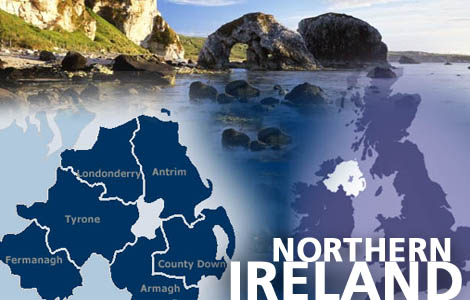 |
|
In 1534, in the middle of the Protestant Reformation sweeping through
much of Europe, the English king Henry VIII signed and sealed the Act of
Supremacy, making himself the head of the English Church. No more Pope.
Though he did it more from pragmatism than from passion, the fighting he
started in England between Catholic and Protestant wasn't done for over 200
years. In Ireland it's going on still.
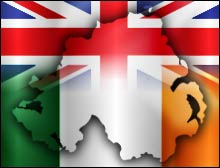 Countries don't change their religion as easily as, say, their sales tax
rate. Henry's daughter got her nickname-"Bloody Mary"-from her attempts
while queen to reverse her Dad's unorthodoxy using means that contained
little hint of Christian charity. Many of her subjects who'd followed Henry
into heresy were dispatched to their reward prematurely, with hundreds
burned at the stake. Mary's Protestant half-sister became Queen Elizabeth I
in 1558 and turned the country around again, re-establishing official
Protestantism, persecuting Catholics, and seeming to settle the issue for
good.
Countries don't change their religion as easily as, say, their sales tax
rate. Henry's daughter got her nickname-"Bloody Mary"-from her attempts
while queen to reverse her Dad's unorthodoxy using means that contained
little hint of Christian charity. Many of her subjects who'd followed Henry
into heresy were dispatched to their reward prematurely, with hundreds
burned at the stake. Mary's Protestant half-sister became Queen Elizabeth I
in 1558 and turned the country around again, re-establishing official
Protestantism, persecuting Catholics, and seeming to settle the issue for
good. Not quite. In 1605, with Elizabeth two years in the ground, there was a failed plot by a group of Catholics (including the much-effigized Guy Fawkes) to blow up the English Parliament with the Protestant king, James I, inside, and at the end of the century King James II, a self-proclaimed Catholic, had to flee his throne and his country to avoid disaster from rising Protestant forces led by the Dutchman William of Orange (later King William III of England).
James' supporters and heirs fought unsuccessfully to regain a Catholic throne of England at the Boyne River in Ireland in 1690 and in the Jacobite (named for James) rebellions, one in 1715 and another, under Bonnie Prince Charlie, in 1745.
But back to Henry and Ireland. England took over Ireland in the twelfth century after the Pope, Adrian IV, obligingly told Henry II of England he could have it. It was never a happy conjunction but it was Henry VIII who poked into the Church, making it even worse, and in 1541 he became "King" instead of merely "Lord" of Ireland
The Reformation was a time of increasing fear of Catholic invasion in England and Henry wanted no problem from the Irish. He crushed what he could of the old ways and replaced them with a Protestant Church of Ireland. It didn't take hold the way it did in England and relations between England and Ireland deteriorated even further. Irish rebellions continued through the 16th century though they were harshly put down.
Under Elizabeth's successor, James I ( a Scot who succeeded the childless queen), the north of Ireland-- largely the province of Ulster-- was settled by English and Scottish Protestants, and many Irish Catholics lost their land. In the mid 17th century another Irish rebellion led to more land confiscations and the loss of many thousands of lives. And more Protestant landlords and settlers in the north.
In response to Irish support for the deposed Catholic James II at the Battle of the Boyne, the Irish Parliament, controlled by English Protestants, stripped Irish Catholics of all power. At the beginning of the eighteenth century, only about 10 per cent of the land in Ireland was owned by Catholics. As a group, their situation was increasingly dire.
In 1800, after yet another Irish rebellion, British Prime Minister
William Pitt decided that the solution to the Irish problem lay in
abolishing the Irish Parliament completely and incorporating Ireland into a
United Kingdom of Great Britain and Ireland. He also wanted full rights for
Catholics but opposition within England was too great. It took until 1829
before the Catholic Emancipation Act passed through parliament, reversing
hundreds of years of restrictions on Catholic rights. But reversing the
effects of those restrictions was even more difficult than reversing the
laws.
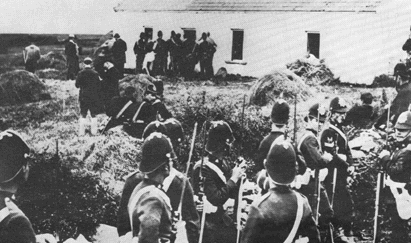 With
Irishmen in the British Parliament, the "Irish Question" became a current
issue. The Irish Catholics were at a severe disadvantage in their own land.
English and Scottish Protestants lorded over Irish tenants. You would have
thought Irish poverty could get no worse. You'd have been wrong.
With
Irishmen in the British Parliament, the "Irish Question" became a current
issue. The Irish Catholics were at a severe disadvantage in their own land.
English and Scottish Protestants lorded over Irish tenants. You would have
thought Irish poverty could get no worse. You'd have been wrong. At mid-century, the main source of food in Ireland was destroyed. Years of potato blight from 1845-49 led to the Great Potato Famine. A million people starved, a million and a half emigrated, most of them to the U.S. The population of Ireland dropped by a third. The only advantage to Ireland to come out of this most terrible natural disaster was that emigrated Irish formed the Fenian Movement (from Fianna Eireann, mythic Irish Warriors) and worked for Irish independence from afar.
There was a small victory in 1869 when the British prime minister, William Gladstone, ended the official status of the Protestant Church of Ireland, and during the 1870s the drive for Irish "Home Rule" picked up steam. In the north of the country, in the counties of the province of Ulster, Protestants became nervous.
Finally, in 1914, Home Rule was enacted (though Ulster was to be excepted for six years), just in time for World War I to cause it to be suspended. Civil war seemed a possibility. In Ulster the Protestants formed a militia. In the rest of the country the Catholics did the same.
|
Two Poems by W.B. Yeats In September 1913 the Irish poet William Butler Yeats chastises his countrymen for their lack of nationalist passion. In Easter 1916 he changes his tune. |
In 1916, with The Great War still raging, the Irish Republican
Brotherhood staged a rebellion against Britain on Easter Monday. Though the
uprising was limited to Dublin and ultimately failed, the leaders were
executed, giving the event an emotional value of enormous proportion and in
1918 the Irish nationalist Sinn Fein ("we, ourselves") party won an
overwhelming victory in parliamentary elections. Instead of reporting to
parliament in England they declared an Irish Republic. The British outlawed
them. The Irish Republican Army was formed, grew increasingly violent. The
British sent troops, the hated Black and Tans.
In 1920 a new Home Rule bill tried again to reach a compromise: separate
parliaments, one for Protestant Ulster, one for the rest of Ireland. In
January, 1922, after much protest from Catholic Ireland, The Irish Free
State, minus six of the nine counties of Ulster, became a Dominion within
the British Empire with its capital in Dublin.
In 1937, under the nationalist (and survivor of the Easter Rising) Eamon de
Valera, Ireland ended Great Britain's sovereignty and in 1949 left the
Commonwealth completely, fruitlessly demanding the return of the Ulster
counties. The partition question -- the re-unification question -- has never
been settled.
And there was always an Irish Republican Army. For a decade after
partition they violently agitated for re-unification of Ireland using guns
and bombs liberally. During WWII, though many internationally-minded
Irishmen fought on the side of the Allies, the IRA openly supported the Nazi
cause while Ireland, though officially neutral, permitted both German and
Japanese agents into the country.
The IRA went completely underground after ultimately being outlawed by both
Ireland and Northern Ireland, and, though responsible for bombs in both
Belfast, the capital of Northern Ireland, and London during the 1950s, their
activities waned considerably. The cycle of violence, the most recent round,
started again in 1968.
It was the height of what we remember as The Sixties. Protest riots
simultaneously rocked and paralyzed Paris, Russian troops put down Czech
reformists, Chicago police clubbed students as cameras rolled for
dinner-hour newscasts. And the Catholic minority in Northern Ireland rose up
for civil rights. They were doubly incensed: victims of political and
economic discrimination, and in their own land.
The Catholic population had grown after the war, largely through immigration
from Ireland. The protests led to violence. Prime Minister Terence O'Neill,
a Protestant and a liberal, had wanted to ease the anti-Catholic
discrimination problem but was forced from power.
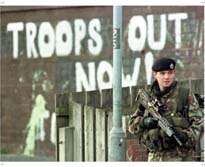 Thirty years of death and hatred have followed in Northern Ireland, spilling
over into England and Ireland. In 1969, troops came from Britain. That same
year the IRA split into the "officials" who renounced violence, and the "provisionals"
who embraced it as an acceptable tool for change. The Protestants produced
their own terrorists, The Ulster Defense Association. In 1972, direct
control of Northern Ireland was taken over by Britain and the Northern Irish
parliament and constitution were suspended.
Thirty years of death and hatred have followed in Northern Ireland, spilling
over into England and Ireland. In 1969, troops came from Britain. That same
year the IRA split into the "officials" who renounced violence, and the "provisionals"
who embraced it as an acceptable tool for change. The Protestants produced
their own terrorists, The Ulster Defense Association. In 1972, direct
control of Northern Ireland was taken over by Britain and the Northern Irish
parliament and constitution were suspended.
There have been acts on both sides since that seem indefensible even using
the most extreme nationalist definitions. There have been many imprisonments
in British jails, some clearly justified, some just as patently not. There
have been acts and provocations that speak of a depth of hatred between
neighbours that's unfathomable to most of us. Each summer, during "marching
season" the Protestant majority rubs their Catholic neighbours' faces in the
victory of the Protestant William at the Boyne, an event over 300 years in
the past. Even though William was a Dutchman and the House of Orange a Dutch
institution.
The reality is several centuries of hatred and disgust passed down to each
new child, a culture in which belonging to one's group requires passionate
and angry feelings about members of another. To the Irish, Northern Ireland
is the last remnant of the ill-gotten gains of an invader, kept when the
rest was returned to rightful sovereignty. To the Protestant majority
however, Ulster is no less than Home.
There is a danger in the age of instant communication and media
pervasiveness that when the positions of rancorous groups are enunciated,
every gesture draws a line in the sand, every tic becomes a blink or a
not-blink. No one can be seen to be weak or even overly conciliatory and
everything represents something else.
There are voices on both sides of the Northern Ireland situation who say the
issue isn't any more "who did what to whom, when." It is only "what can we
do now to make everyone's situation better." We have seen striking evidence
in the past decade that people who hate and mistrust each other can try to
make arrangements for their mutual benefit, even over the obstructionism of
frenzied nationalists.
In the short term, such pragmatism may reduce the violence. In the longer
term, it may reduce hatred. But this mess started in 1171.
In April 1998, the Good Friday peace accord was
signed. It was a tentative deal that included both the Ulster Unionists
(Northern Irish who wish to remain allied with Britain) and Sinn Fein (the
political wing of the IRA, Catholics who wish to rejoin Northern Ireland to
Ireland.) The historic agreement provided for a new governing council, or
executive, with Protestant and Catholic representation.
An historic agreement, to be sure, but the road to implementation proved to
be bumpy.
To the Ulster Unionists, anything less from the IRA than unequivocal
agreement to disarm was a statement in favour of continued terrorism. And
though the IRA had accepted a cease-fire, they had not completely renounced
violence.
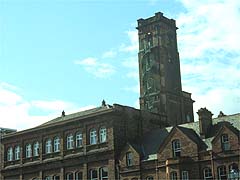
The Ulster Unionists refused to sit with Sinn Fein until the IRA sent an unequivocal message that it would disarm. Sinn Fein would give no such assurances, and fears grew that the Good Friday accord would die and Northern Ireland would lapse back into the killing of neighbours and of neighbours' children.
To the IRA, without the defence budget of a major industrialized nation behind it, replacing weaponry is no small or inexpensive job and moving slowly toward giving up its leverage is a quite practical issue. And it's not as if the Irish Republican arsenal could be kept like a deposit by the British, to be returned if the deal doesn't work out.
The historic day finally arrived on the last Monday of November, 1999, when the 108 members of the Northern Ireland Assembly voted to form a coalition government, with an executive of Protestant and Catholic members. For the first time, Protestant Unionists and Catholic Republicans pledged to share power.
The deal worked out at the meeting of the Assembly in Belfast created an Executive made up of members from the four main political parties. The Ulster Unionist Party (UUP), lead by David Trimble, would hold four seats on the Executive. Trimble also became the First Minister. The moderate Social Democratic and Labour Party (SDLP), contributed four Catholic members to the Executive, one of whom became the deputy First Minister. The hardline Protestant Democratic Unionist Party and Sinn Fein each were given two seats on the Executive.
The Executive will take over the running of Northern Ireland's affairs, except for taxation and security matters. The British government officially transferred power to the Executive by the end of the week, marking the first time since 1974 that the volatile British province experienced home-rule government.
Another historic event was expected in Dublin at the end of the week, when the Irish parliament would approve a constitutional amendment revoking its claim to the territory of Northern Ireland. This was regarded as an important step in convincing the majority of Protestants in Northern Ireland that they would not be forced into a union with the Republic without their approval.
The IRA and other paramilitaries agreed to appoint
disarmament representatives to deal with the contentious issue of stockpiled
weapons. This was to be worked out between the IRA and General John de
Chastelain, a Canadian heading the disarmanent commission.
This "rescue package" was worked out at the 11th hour in talks mediated by
former U.S. Senator George Mitchell. It allowed Trimble, the UUP leader and
new First Minister, to buy time on final approval of the peace package
despite the weapons issue. The UUP was promised final approval of the
package at a party convention in February, 2000.
On Wednesday, December 1, 1999, in London, the Queen formally gave her seal
of approval to a law ending 27 years of Britain's direct rule of Northern
Ireland. She used only one word at the brief ceremony at Buckingham Palace.
The Queen said, "Approved."
The power sharing agreement in the Good Friday Accord led to a multiparty,
Protestant/Catholic government with the Ulster Unionist Party leader David
Trimble as first minister. The Accord included provisions for disarmament -
"decommissioning" - of arms by the various paramilitary groups on both
sides.
Since the Accord, the Irish Republican Army's continuing refusal to comply
with decommissioning has angered Protestants. And the Protestant
sluggishness with addressing IRA concerns including reformation of the
Protestant police force called the Royal Ulster Constabulary and reduction
of British military presence has angered the IRA.
In February 2000, the British government intervened to broker a deal for
decommissioning. In May 2000 the IRA agreed to begin decommissioning by the
end of June 2001.
However IRA decommissioning did not take place by June 31, 2001. In response
David Trimble resigned as first minister of the Northern Ireland Assembly. A
six-week suspension of parliament gave negotiators some time to attempt to
reach an agreement between the IRA and the assembly.
In August the IRA offered to begin the decommissioning process. The offer
was refused by the Northern Ireland Assembly since it did not include a
timetable for action.
Then suddenly, in October 2001, the IRA announced that it would put some of
its weapons "beyond use," a move that was confirmed by de Chastelain's group
of observors. Britain responded with a pledge to begin reducing its military
presence in Northern Ireland.
With the ending of direct rule, much of the world hoped that the cycle of
violence in Northern Ireland would end. So far, there has been a
continuation of the bumpy ride that has shaken the country since the 16th
century.